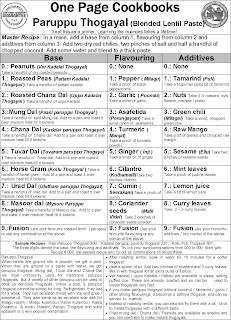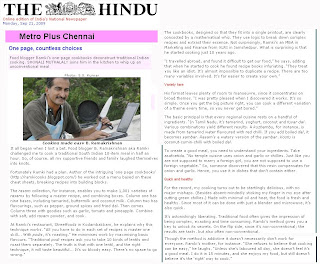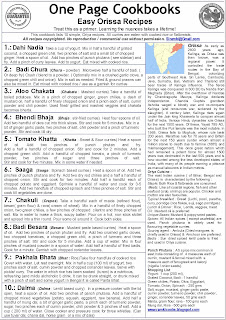
Click the image to view and print the cookbook. This cookbook lists variations of the following Paruppu Thogayals ( roasted and ground lentil - chili paste) from Tamil cuisine
0.: Ver Kadalai Thogayal
1.: Pattani Kadalai Thogayal
2.: Uppu Kadalai Thogayal
3.: Paasi paruppu Thogayal
4.: Kadalai paruppu Thogayal
5.: Tuvaram paruppu Thogayal
6.: Kollu Thogayal
7.: Ulutham paruppu Thogayal
8.:
When roasted lentils are ground into a powder with dry red chilies , we get a podi. When they are ground to a paste with water, we get paruppu thogayal. Mung dal, Tuvar dal and Chana Dal are most commonly used for traditional paruppu thogayals. But a variety of other paruppu can be used to cook up delicious thogayals. Unlike a podi, a paruppu thogayal cannot be stored for long. Refrigerated, they last for a week. They can be eaten mixed with rice and ghee / sesame oil. They also serve as an excellent side dish for Milagu rasam / Milagu kulambu / Vatral Kulambu / Kaara Kulambu & kootu. Rasam, Parupu Thogayal and sutta appalam is a very popular combination.
· After roasting lentils, soak in water for 10 minutes for a softer thogayal.
· Heat a spoon of oil. Add two pinches of mustard and 3 curry leaves. Mix in with thogayal for an extra burst of flavour.
· Ver Kadalai / Uppu Kadalai / Pattani are available in shops selling puffed rice. These are already roasted and so can be used to create instant thogayals.
· If you make paruppu thogayal without coconut / tamarind / garlic / other strong flavourings, it becomes a pathiya thogayal, and can be served to invalids.
· Instead of roasting lentils, you can also stir fry them with a bit of oil to create thogayals with a different taste. Fried mung dal / Chana dal / Peanuts are available as snacks and you can use them to make instant thogayals.
Check out detailed recipes and great pictures from fellow bloggers.....
1. Rajeswari's Tuvaram Paruppu Thogayal
2. Vibass' Tuvaram paruppu Milagu Thogayal
3. Kribha's Poondu Paruppu Thogayal
4. Vidhya's Kadalai paruppu Thogayal
6. Komala's Pasi paruppu thogayal
Since Paruppu thogayals are built on red chiles & lentils, the chili part of them take them to Kitchen Chronicles' "Think Spice- Red Chilies", an event started by Sunita Bhuyan, and the lentils take them to Mosoon spice's MLLA, an event started by Susan.









